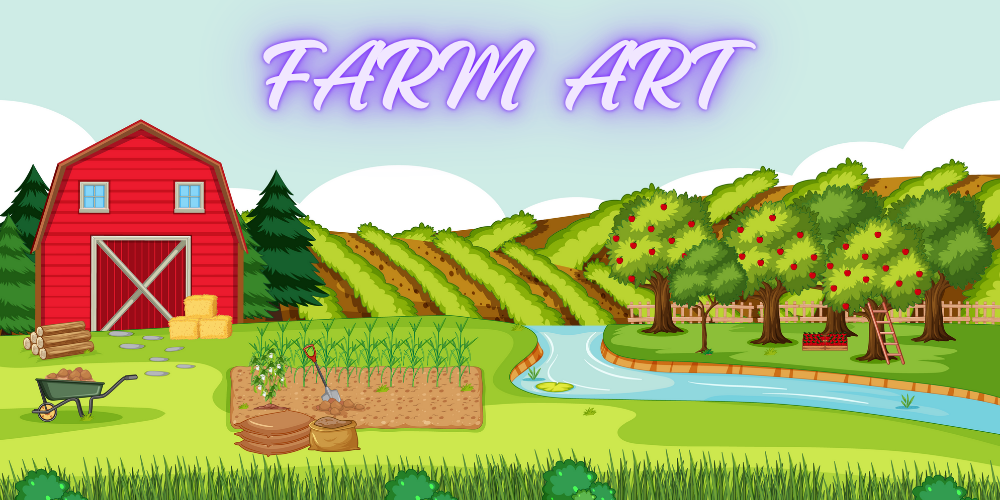The idyllic countryside, with its rolling hills, rustic barns, and fields of gold, has long been a source of inspiration for artists. But what happens when the canvas extends beyond the traditional easel and into the very landscape itself? Welcome to the fascinating world of Farm Art, where agriculture and artistic expression intertwine in exciting and unexpected ways.
Farm Art, also known as Land Art or Environmental Art when created in rural settings, is a diverse and evolving genre that utilizes the farm environment as both a source of materials and a platform for creative endeavours. From sculptures made of hay bales to murals painted on silos, Farm Art transforms the working landscape into an immersive art experience, inviting viewers to engage with the environment in meaningful and new ways.
The Roots of Farm Art
Though Farm Art may feel like a modern creation, its roots go back centuries. Early human societies also integrated agricultural work into their religious and artistic expression, choreographing elaborate fields and colossal earthworks that reflected seasonal and cosmic rhythms.
During the 20th century, artists began to consciously look to the countryside for sites of artistic practice. The Land Art movement of the 1960s and 1970s, with artists like Robert Smithson and Nancy Holt, involved artists travelling to wide, remote spaces to create monumental expressions that regarded natural elements.
Simultaneously, a growing awareness of environmental issues and a desire to reconnect with the land led artists to explore the agricultural landscape as a source of inspiration and a site for creative intervention. Farm Art emerged as a way to celebrate the beauty and bounty of the countryside while also raising questions about our relationship with the natural world and the sources of our food.
Diverse Expressions of Farm Art
Well, Farm Art is many things, just like art itself. Some artists, using natural materials like leaves, branches and ice, build and destroy their own installations in sync with the seasons: ephemeral works that rot, sprout or melt, change and disappear over time. Some make permanent sculptures from used farm equipment, turning rusted implements and machines into whimsical figures or thought-provoking commentary.
The most talked-about art form under Farm Art is Crop Art, and farmers use various types of crops to design magnificent designs and pictures in their fields. Seen from a birds-eye vantage point, these living works of art turn the land into a colossal canvas, celebrating both the artistry of agriculture and the beauty of nature.
Mural painting on barns and silos has also become a widespread form of Farm Art, bringing vibrant colours and imagery to the rural landscape. These murals often depict scenes of farm life, local wildlife, or abstract designs, adding a touch of artistic flair to the functional structures of the farm.
Other examples of Farm Art include:
- Sculptures: Utilizing hay bales, stone, wood, and recycled farm equipment.
- Installations: Creating interactive experiences or site-specific works that respond to the environment.
- Performance art: Engaging with the landscape through movement, sound, and ritual.
- Photography and film: Documenting the beauty and challenges of rural life.
The Impact of Farm Art
Farm Art has a multifaceted impact, enriching the lives of both artists and communities while also contributing to the sustainability of rural environments.
For artists, Farm Art is a unique opportunity to align with the land, try out new materials and methods, and discover a broader audience. This encourages longer dialogues between creator and land, where artists can rethink the relationship between their work and the surrounding context.
For communities, Farm Art provides a source of pride and identity, attracting tourists and generating economic opportunities. Farm Art festivals and events bring people together, fostering a sense of community and celebrating the cultural heritage of rural areas.
For the environment, farm art can help promote sustainability, raise awareness of environmentalism, and solve environmental problems. Using recycled material and involving nature in their art can help them to begin to see how fragile the ecosystem is and how land is the foundation of so many things as a land steward responsible for what they produce.
Farm Art Around the World
Farm Art is a global phenomenon, with artists and communities across the world embracing the creative potential of the agricultural landscape.
In Japan, the Tanbo Art movement has gained international recognition for its stunning crop art creations, where farmers use different varieties of rice to create intricate images in their paddy fields.
In the United States, the Art Farm movement encourages collaboration between artists and farmers, transforming working farms into vibrant cultural centres.
In Europe, numerous Land Art projects have revitalized rural areas, attracting tourists and promoting sustainable development.
Conclusion
Farm Art is proof that the ties between humans and the earth remain strong. Farm Art is an annual event that transforms the working landscape into a canvas for creative expression to celebrate the beauty and bounty of the countryside. We can ask ourselves questions about the art of living.
As the field expands the horizon, it will surely lead us to incredible productions that fill up with balanced art and farming angles of life and increase the beauty of the social enrichment and feeding process for the artist and the entire surrounding communities.
Disclaimer
It is a general guide to Farm Art. This blog reflects the views and opinions of its author and does not necessarily represent the official policy or position of any other agency, organization, employer or company.


